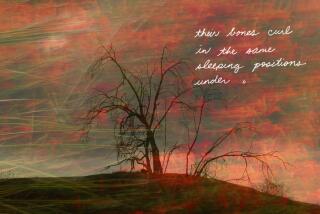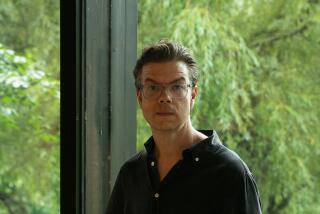A New Language : THE INVENTION OF THE ZERO, <i> By Richard Kenney (Alfred A. Knopf: $20; 152 pp.)</i>
- Share via
Genuine poetic innovation is rare. In an age dedicated to an ideal of ceaseless change it may be more difficult to determine who possesses the true coin of originality, since bona fide renewers of the language often receive less attention than their boisterous colleagues. Reinventing poetic discourse is a solitary occupation.
One such innovator is Richard Kenney, whose work demonstrates that the way forward may depend as much on a profound look into the past as on one’s grasp of the present.
In his first collection of poems, “The Evolution of the Flightless Bird,” winner of the Yale Series of Younger Poets competition, Kenney revitalized the unfashionable form of the extended sonnet sequence, roughening his meters, playing fast and loose with his rhymes, all in an effort to answer or articulate the dimensions of a single question: “Who knows what ark we’ve come to build?”
In “Orrery” he used the lyric particulars of a Vermont cider-milling farm--Robert Frost’s literary terrain--to study the art and physics of love, the watchworks of the title furnishing the volume’s controlling metaphor.
Now, in “The Invention of the Zero,” Kenney’s third and most ambitious book, “the Golden Anniversary of certain heavy elements”--i.e. of the Atomic Age--is the ground (or ground zero?) for his exploration of our changing world.
If the governing myths of modernity derive to some extent from the scientific revolution, then poets interested in creating wisdom literature will not duck the challenge of fashioning music for the discoveries of Charles Darwin, Albert Einstein and the other scientific giants still shaping our vision. “Poems of Science?” James Merrill asks in “The Changing Light at Sandover,” which shimmers in the background of “The Invention of the Zero.” (Kenney has dedicated his book to Merrill, and in several passages one can hear the older poet’s voice sing out, though this in no way diminishes his originality.) The answer is clearly yes.
What first impresses is Kenney’s language, which is at once gorgeous, exact and difficult to penetrate. Some readers will be put off by its archaisms, and the poet’s description of his methods in the “Notes and Acknowledgments” only reinforces the radical nature of his project:
“I’m recalling what Auden in his own work called ‘curious prosodic fauna’; here, sired by Darwin on Celtic consonance, an undescribed subspecies of mutating end-rhyme brachiating down the ragged margin of an hexameter (common, sprung, or truncate) understory, camouflaged and hard to spot in low light, maybe, audible still above such marsupial yelps and jungle cheeps and vocative tectonic splinterings. . . .”
The best approach to the four narratives and short colloquies included in “The Invention of the Zero” is to read them in the same spirit that T.S. Eliot invoked in his preface to St. John Perse’s “Anabase”: “It is to be expected that the reader of a poem should take at least as much trouble as a barrister reading an important decision on a complicated case.” Readers who take such trouble will be delighted by the range and quickness of Kenney’s mind:
What industry our species show! What strange and mad anathemas
We’ve uttered on ourselves here in this smoky maze
We’ve made our home, unraveling the single plume
Of orange flame whose wick braids up from some dry wadi
Somewhere in East Africa, to thread the gloom
Of Quattrocento caves, though Attic
Lime-kilns, lit cathedrals--each illuminated
Mass we’ve cupped in mind since Quaternary
Time began--
These lines come from the title poem, which is a meditation on an early atomic explosion in the New Mexico desert. It ends on a haunting note:
And what’s ahead? Night’s end, a windshield touched to shards
And sifted into sky again? A sleep? A silence
Sliced clean at the closing iris, shuttered
Down like a blue garrote across the lens and burst
Zero of the instant, here, where the watchface lends
Its own light, by the numbers, green and cool, where I first
Witnessed--what?--their afterbirth?--their avatar?--
Beginnings, say, or ends, rehearsed?--the day they lanced
The surfaces of things, and bled from a fist
Of warm earth the quick inhuman light of stars.
Kenney’s narratives depend on digression, which makes them more interesting than the recent ruck of American narrative poems. It is true that a story is buried in each of these long poems--a cross-country drive by a witness to that early atomic test, a chess match officers played at a forgotten military outpost in the Galapagos Islands. But the story is little more than scaffolding on which the poet hangs his music.
“The Invention of the Zero” is an astonishing book, one that with each reading yields more pleasure. “What change can I recall, or work?” the poet asks. “I’m doomed to overstatement, last as first: / a sun’s reintroduction, new forms of worship, fustian / as ever: air, earth, water, fire .” What Richard Kenney writes and ritualizes in these poems are those very forms of worship.
More to Read
Sign up for our Book Club newsletter
Get the latest news, events and more from the Los Angeles Times Book Club, and help us get L.A. reading and talking.
You may occasionally receive promotional content from the Los Angeles Times.







